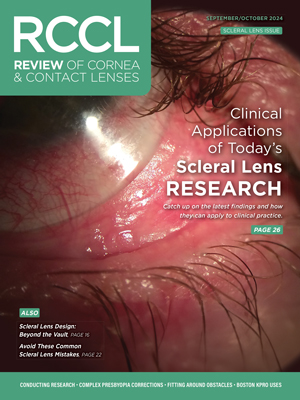 Whether it is getting started with a new fit or trying to improve a current one, GP lab consultants are an invaluable part of fitting GP lenses successfully. Many of us, however, do not take advantage of these consultation options as often or as effectively as we could. In this month’s column,
Whether it is getting started with a new fit or trying to improve a current one, GP lab consultants are an invaluable part of fitting GP lenses successfully. Many of us, however, do not take advantage of these consultation options as often or as effectively as we could. In this month’s column,
I spoke with Dan Bell, president and lead consultant of Corneal Design Corporation in Gaithersburg, Md., to discuss how consultants view their interactions with contact lens fitters and to ask for suggestions on how to maximize the time and effectiveness of this communication.
Consultation Etiquette
• Do not have a staff member fill your shoes. First, and perhaps most importantly, Mr. Bell made it clear that consultations should involve the individual doing the fitting, not a staff person. When the individual who is calling into a consultation is not the one who has first-hand knowledge of the patient (e.g., seen the lens fit, discussed complications and knows the lens fit history), you do not get the most out of a consultant’s time.
I had incorrectly assumed that, in most cases, the fitter was the one asking for a consultation. But Mr. Bell said that in almost half the cases, it is a staff person who calls to order the lens through consultation on behalf of the practitioner responsible for the fitting. Instead, ask your office staff only to order lenses that do not require consultation through customer service. Do not ask someone in consultation to work with a staff member who may not be prepared to answer questions based on patient interaction and as such, provide the information needed to optimize the fit.
• Be thorough in your assessment. If you anticipate the need for consultation, be sure to collect all data that may be crucial to consultation, including keratometry, over-refraction or fluorescein evaluations of the lens fit. When looking at a lens, Mr. Bell suggested not only to look at the fluorescein pattern but also to take note of how the lid interacts with the lens and what it looks like as the patient blinks and moves his or her eye.
• Come prepared. Mr. Bell said to collect all paperwork, including your patient’s chart, and complete the necessary testing prior to scheduling a consultation. Also be sure to inform your lab consultant about any potential complication(s) with the lens fit. Dry eye, thyroid disease, pregnancy, estrogen use and systemic medication use for conditions like high blood pressure or allergies are all important factors when trying to determine why a patient is struggling with lens wear or noticing changes in vision.
Similarly, images of diagnostic tests (e.g., corneal topography) or photos of patients’ eyes with or without lenses can be very useful to consultants.
Make sure that the images are high resolution and in color, so they can be accurately interpreted. Also, be sure to scan and email topographies rather than sending a fax.
• Plan your schedule accordingly. Block out an appropriate amount of time when you schedule your call with the lab consultant. Take the time to learn the specifications, materials and design of the lens you are discussing; how the consultant is planning to alter the parameters; and why these changes may improve the patient’s experience. The more you understand about how lab technicians can change a lens and why they are doing so, the less likely you are to need future consultations––and the more likely you are to take better advantage of the service.
Fitting guides are wonderful tools, and experience is priceless. But your lab consultant is also a crucial component of the GP lens fitting process. He or she is there to help make lens fittings easier and more predictable. Whether it is recommending the best design for a particular patient’s needs, helping to improve a fit that is not working as well as it could, or giving you the latest information on a lens design’s intricacies, your lab consultant should be a resource that you call on routinely.


